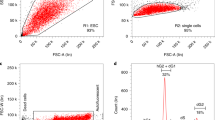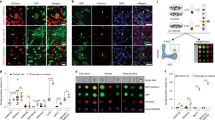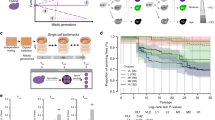Abstract
FIFTEEN years after the first somatic cell hybridisation1, there are still no reports of the successful isolation of proliferating populations of pure synkaryons between strains of euploid mammalian cells. Migeon et al.2 fused suitably marked human fibroblasts and lymphocytes using a selective medium, but they were unable to isolate further and characterise the presumptive hybrid subpopulation. No one, to our knowledge, has been able to obtain synkaryons between euploid cells without the use of biochemical selective techniques. Such an achievement would be highly significant, since it would facilitate mating between any pair of euploid somatic cells for which there are few selective2, but many3 differentiating markers.
This is a preview of subscription content, access via your institution
Access options
Subscribe to this journal
Receive 51 print issues and online access
$199.00 per year
only $3.90 per issue
Buy this article
- Purchase on Springer Link
- Instant access to full article PDF
Prices may be subject to local taxes which are calculated during checkout
Similar content being viewed by others
References
Barski, G., Sorieul, S., and Cornefert, F., C.r. hebd. Séanc. Acad. Sci., Paris, 251, 1825–1827 (1960).
Migeon, B. R., Norum, R. A., and Corsaro, C. M., Proc. natn. Acad. Sci. U.S.A., 71, 937–941 (1974).
Harris, H., and Hopkinson, D. A., Ann. Hum. Genet., 36, 9–20 (1972).
Martin, G. M., Sprague, C. A., and Epstein, C. J., Lab. Invest., 23, 83–92 (1970).
Norwood, T. H., Pendergrass, W. R., Sprague, C. A., and Martin, G. M., Proc. natn. Acad. Sci. U.S.A., 71, 2231–2235 (1974).
Sprague, C. A., Hoehn, H., and Martin, G. M., J. Cell. Biol., 60, 781–784 (1974).
Puck, T. T., Marcus, P. I., and Cieciura, S. J., J. exp. Med., 103, 273–284 (1956).
Lejeune, J., Turpin, R., and Gautier, M., Revue Fr. Etud. clin. biol., 5, 406–408 (1960).
Pera, F., and Rainer, B., Chromosoma, 42, 71–86 (1973).
Rizzoni, M., Palitti, F., and Perticone, P., Chromosoma, 45, 151–162 (1974).
Smith, J. R., and Hayflick, L., J. Cell. Biol., 62, 48–53 (1974).
Burnet, M., Intrinsic Mutagenesis. A Genetic Approach to Ageing (Wiley, New York, 1974).
Nadler, H. L., Chacko, C. M., and Rachmeler, M., Proc. natn. Acad. Sci. U.S.A., 67, 976–982 (1970).
Lyons, L. B., Cox, R. P., and Dancis, J., Nature, 243, 533–534 (1973).
Thomas, G. H., Taylor, H. A., Miller, C. S., Axelman, J., and Migeon, B. R., Nature, 250, 580–582 (1974).
Author information
Authors and Affiliations
Rights and permissions
About this article
Cite this article
HOEHN, H., BRYANT, E., JOHNSTON, P. et al. Non-selective isolation, stability and longevity of hybrids between normal human somatic cells. Nature 258, 608–610 (1975). https://doi.org/10.1038/258608a0
Received:
Accepted:
Published:
Issue Date:
DOI: https://doi.org/10.1038/258608a0
This article is cited by
-
Segregation of mitochondrial DNA in human somatic cell hybrids
Molecular and General Genetics MGG (1984)
-
Expression of the fragile site Xq27 in fibroblasts. I. Detection of Fra(X)(q27) in fibroblast clones from males with X-linked mental retardation
Human Genetics (1983)
-
Systematic growth studies, cocultivation, and cell hybridization studies of Werner syndrome cultured skin fibroblasts
Human Genetics (1981)
-
Normalisation of sister chromatid exchange frequencies in Bloom's syndrome by euploid cell hybridisation
Nature (1979)
-
Non-selective isolation of human somatic cell hybrids by unit-gravity sedimentation
Nature (1979)
Comments
By submitting a comment you agree to abide by our Terms and Community Guidelines. If you find something abusive or that does not comply with our terms or guidelines please flag it as inappropriate.



